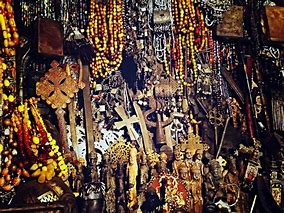
Mercato is the market for so many essential things in our lives. It is still the biggest market for anything imaginable under our sky. The list is long and I don’t dare go into the details. Everyone knows what Mercato means and what it stands for. It is even a symbol of survival for the last 90 or so years after the Italians established it as a segregated market for indigenous people while places like Piazza were inaccessible except to the occupiers. At one time, Merkato was a major attraction. Foreign tourists were attracted by its history and wanted to see it in action. It was a staggering sight, the largest in Africa, rightly dubbed the “biggest open-air market” on the continent.
As anything changes through time, Mercato too has changed its face in the last many years. Instead of horizontally built shops that were largely ramshackle structures, there are now modern buildings that are housing all kinds of shops, neatly arranged, packed with goods and service providing outlets, and varieties of commodities of all colors and descriptions.
To my surprise, I have not come across shops for traditional Ethiopian artifacts and works of arts gather in one place. They are still found in the older Adarash buildings. Traditional artifacts are by definition traditional. Their values are determined by their longevity. The older the artifacts, the more value they have or the more expensive they become. That is perhaps the secret of their survival. They always enjoy demand. There is something of generational succession. Members of each generation want to discover Mercato to know about its treasure trove of traditional artifacts.
As far as artifacts are concerned, Mercato is a kind informal museum of our traditional heritages. This is a museum built by life, spontaneously, and without neither a plan nor a budget. It is not only a place for marketing. It is also a place to be visited so that we can look at our past, at our grassroots arts created by popular imagination which is the embodiment of our past and present.
My vision for the Mercato artifact market which is now found within the old Adarash display building is the following. This building is part and parcel of the history of the market. What they put on display or for sale is also part and parcel of our history because the artifacts on display there come from various places and people belonging to different ethnic groups and traditions.
The Adarash, and its artifacts is therefore is our collective popular museum. These artifacts and traditional heritages should not be dispersed or located in various places or in various buildings. My vision is that they should be located in one big building exclusively dedicated to serve as the meeting point for all tourists, researchers and visitors where they could find not only the history of the marketplace but also our own artistic history within it. That building would be a museum, a market, a piece of living history, all in one.
The virtue of allocating different sites for markets dealing with different items is obvious. In the British capital London, there are places especially dedicated to different activities. What is called “The City” in London is the financial nerve centre of the capital where all financial transactions and stock exchanges take place. Banks, stock trading centers and related activities are found congregated in that particular place. “The City of London, also known as the Square Mile, is the financial district of London. It is the ancient core from which the rest of London developed.
We have already have a good example here in Addis. Most of the big banks in the capital are located at one place around the new Commercial Bank of Ethiopia or the older National Bank of Ethiopia buildings in the downtown areas. This is slowly becoming the financial center as new banks will located their headquarters in the same area. This is not done following a plan but spontaneously. Being near the central bank has its advantages both for the banks and their clients.
There was also another famous milestone in London where all newspapers were published and distributed. At one time, it was known as Fleet Street. It was home to many British newspapers including The Times, The Daily Telegraph and the Daily Express. The street was at the height of its popularity in the early 20th century. It was famous for its history in journalism and printing. it’s also home to notable architecture and has connections to literary and musical figures. British journalism therefore grew out of this particular area.
These are now historical places that are visited by scores of tourists every day because they showcase the history of London. Why not emulate or duplicate these kinds of positive experiences in our own capital? Why not allocate specific areas in Addis, say for book markets where all book sellers would find their niches in single or multiple buildings located in one specific area. This may have its own advantages. First, all booksellers and book buyers will converge in the same area allocated for the specific purpose.
Secondly book buyers may enjoy the advantage from competition when book sellers are located in the same building or buildings. Prices might be regulated by demand and supply and be set at their ideal average. Nowadays, the same book may have widely differing prices when sold and bought from different bookshops in the capital. By the way, the trend of opening bookshops in every new building in Addis is a welcome trend that shows the virtue and advantage of operating from the same area both for book sellers and book buyers.
In this hypothetical scenario, we can imagine that recently demolished or evacuated book shops in Piazza and elsewhere in the capital could come together in one building and restart their activities instead of shifting to other occupations out of despair. It may be difficult if not impracticable to allocate every bookshop at different sites in Addis. The best option would be to bring them together in one area locate them in a single building, probably not an expensive high rise but a modest one. We can perhaps replicate this alternative for other items like the traditional artifacts markets either within Mercato or outside it, by renting already existing buildings or by building a new one in the future.
Book markets in general do not seem to be doing well in the ongoing city renovation initiative around the old Piazza area in particular. The bookshops in Piazza were not modern ones as such. They were small shops built with metal and zinc sheets, single-room structures large enough to have one-room spaces to shelter only the booksellers and the books for sale. The shops were built a long time ago when some of the municipal authorities who apparently understood and loved culture decided to allocate the plot for building the small bookshops that were strategically located right in front of the Saint George church, a very crowded place and the ideal meeting place for bookworms and booksellers.
The street sides or pavements of Addis had long been the ideal locations for selling and buying traditional objects of arts. Take for instance a famous art location on the famous Churchill Road where artifact and art works were displayed for sale. Among other things, the spot is also famous for attracting foreign tourists who are fond of the items on display there, the clay pots, incense burners…etc.
The evacuation of book sellers may not be the result of a deliberate or irresponsible decision. It may not be a calculated move to throw them outside the centre of the city and push them away into the outskirts. The people assigned to design the renovation of the capital might not be as cynical as some observer may believe. The markets and residential houses in Piazza just happened to find themselves in the wrong places at the wrong time, at this time of breakneck demolition and reconstruction. This is how life moves on. There are always losers and winners in the this tug of war.
True, city renovation is not a work of charity. It may sometimes appear even cruel, irresponsible and irresistible. The process is so fast that observers may not get enough time to articulate their arguments or process their thoughts. The process goes on at a fast pace. There is no time for procrastination, arguments or debates. It all depends on the decisions of the municipal authorities although their intentions may sometimes be controversial.
The renovation process does not discriminate and the bulldozers simply remove what the municipal authorities and their planners had found archaic, ugly and derelict. They are slated for renewal and give room to the new and the more beautiful. Gold and silver jewelry shops, outlets for stylish brand clothes, cinema halls,…the posh marketing neighborhoods were not spared. Now, the dust has settled and the shock of the first moments has receded to the background.
You may sometimes be forced to eradicate an art centre to give way to the non-artistic. Hager Fikir Theatre, one of the oldest art institutions where the first plays in the country were staged, the first poems were read by the first poets of the post-war generation, all of them are now gone and joined the ranks of the fallen ones. Hager Fikir may not be the Russian Bolshoi Theatre. But it had its dignity and its right to survival. Whatever the case may, be no one in their right mind would delight seeing venerable artistic centre disappear like that.
Hager Fikir is not entirely removed. My suggestion is that it would be smart to build a high rise building on the little plot of land that has escaped the demolition roller coaster and give the theatre house a new lease of life. Let’s hope that we may one morning wake up to see the artifacts shops in Mercato, the bookshops dotting the capital and everything that smells of arts, enjoying a new life in modern glass and aluminum buildings, away from the chaos and confusion of their past lives.
BY MULUGETA GUDETA
THE ETHIOPIAN HERALD THURSDAY 13 MARCH 2025


